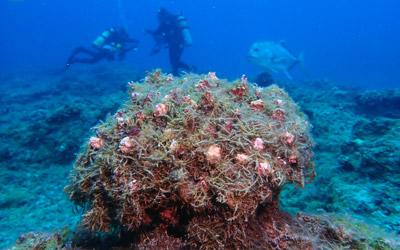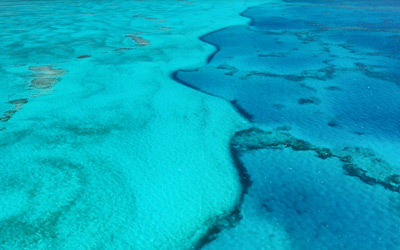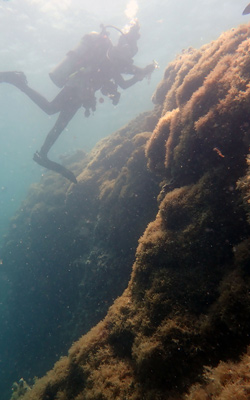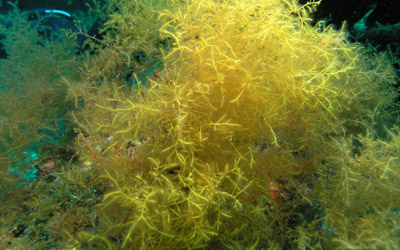News
Researchers Collect Data on Nuisance Alga in Papahānaumokuākea Marine National Monument
A research expedition in Papahānaumokuākea Marine National Monument has returned to O‘ahu after 20 days at sea collecting data on a nuisance seaweed at Manawai (Pearl and Hermes Atoll). Thick mats of the invasive-like alga, Chondria tumulosa, were documented in 2019, overgrowing and smothering native corals and algae at Manawai. It was identified as a species new to science in 2020.
During this research cruise, divers documented Chondria at approximately 30% of the locations that were surveyed, in dense, attached mats that were up to nine inches thick and hundreds of square meters in extent. Although the data collected will take six months to a year to analyze, the amount of algae does not appear to have diminished, and may have increased since the last observations in 2019.
Research Focus

The expedition, led by NOAA’s Office of National Marine Sanctuaries, included researchers from the College of Charleston, University of Hawaiʿi, NOAA Papahānaumokuākea Marine National Monument, and the University of Alabama. Research was supported by the National Fish and Wildlife Foundation, NOAA’s Office of National Marine Sanctuaries and NOAA’s Office of Marine and Aviation Operations.
The research focus of the expedition was to investigate the distribution, physiology, and ecology of the nuisance alga and determine the oceanographic conditions at Manawai that might be fueling its rapid growth. To date, Chondria has not been confirmed to occur at any other location in the world.
“Given the ability of this alga to form dense mats, reproduce, and fragment readily, its potential to spread to other locations in the Hawaiian Archipelago is high,” says researcher Dr. Heather Spalding, College of Charleston.
Preventing the Spread
To help prevent its spread, best management practices were developed by the monument co-trustee agencies for any vessels approved to travel near Manawai. All diving gear and boats are soaked in high concentrations of bleach solutions and examined for fragments of the alga prior to departure from Manawai.
Distribution Surveys

NOAA researchers used video and satellite imagery to document the spatial extent and distribution of Chondria. They noted the presence of a 20-foot wide swath of unattached “tumbleweeds.” Footage showed the accumulation of the tumbleweeds extended for several miles. The tumbleweeds are live and viable, and may represent a mode of reproduction and dispersal by the alga.
“GPS-tracked diver and video surveys of Chondria will be used with collaborators at the University of Hawaiʿi and NOAA to confirm data from satellite imagery of the atoll, in order to track the distribution of shallow areas invaded by the alga,” says Keolohilani H. Lopes Jr., JIMAR field logistics technician with Papahānaumokuākea Marine National Monument.

Sample Collection
Hundreds of Chondria samples were collected and preserved for genetic analysis to help determine if this species forms a single population, or several different populations around the atoll.
“This may help us to understand if this is a native alga gone wild, or an introduction from another location,” says Taylor Williams, a graduate student at the College of Charleston.
Water samples were also collected by University of Hawaiʿi graduate student Jimmy Fumo to determine if environmental DNA (eDNA) analyses can be used to detect the nuisance alga at other locations where it may be difficult to visually detect at low densities.
Not Fish Food
Despite the presence of large schools of herbivorous fish, researchers have found no evidence that fish or other organisms are consuming Chondria as part of their diet
“I observed one fish take a bite and then spit it out. Additional studies on the anti-herbivory compounds or palatability of this alga are needed,” says Brian Hauk, Papahānaumokuākea Marine National Monument’s chief scientist for the expedition.
New Species

While conducting surveys, scientists collected what appears to be a new species of subtidal red algae from Manawai. The red alga has a distinctive yellow fluorescence at depth, and was found growing among native algae and corals. To date, it has not been found anywhere else in Hawaiʿi.
“We’re still in the process of documenting the diversity of algae in Hawaiʿi. It’s starting to feel like a race against the invasive species – trying to understand what’s here before it disappears,” says Dr. Spalding.
Continuing research is necessary to better understand how best to manage this alga, and other potential threats to the monument.


